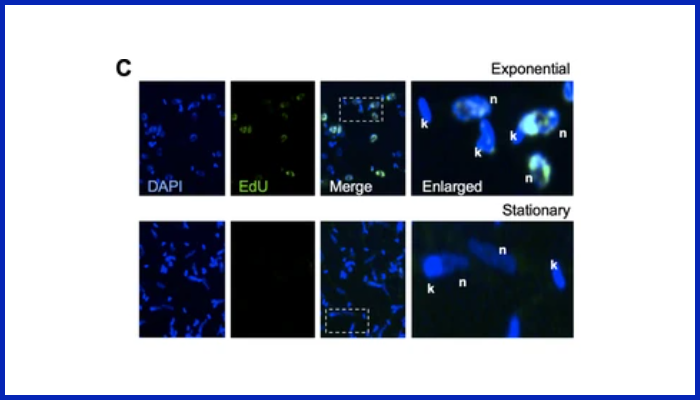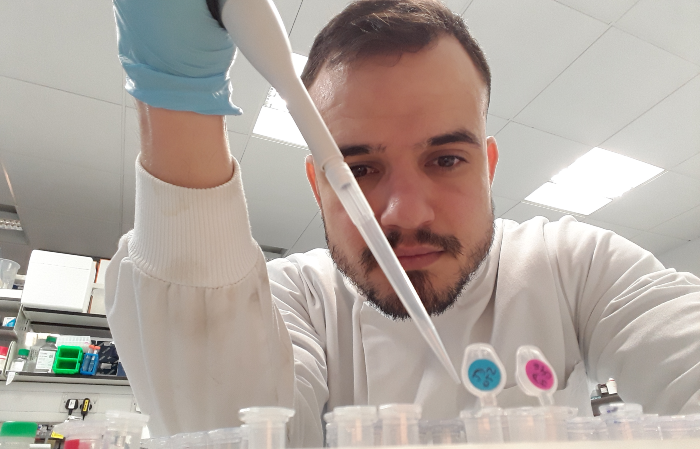Genome duplication in Leishmania major relies on persistent subtelomeric DNA replication
Published: 24 September 2020
New research by Institute scientists has provided a better understanding of how the parasites causing leishmaniasis replicate their genome prior to cell division - a discovery that could ultimately lead to a better quality of life for sufferers.

New research by Institute scientists has provided a better understanding of how the parasites causing leishmaniasis replicate their genome prior to cell division.
The work, led by Dr Jeziel Damasceno, saw colleagues from our Wellcome Centre for Integrative Parasitology (WCIP) collaborate with the University of Sao Paulo's Ribeirão Preto Medical School to examine how Leishmania organises DNA replication spatially, temporally and functionally.
Their findings, published in eLife, could help in the design of novel drugs and ultimately lead to a better quality of life and economic benefits for sufferers as well as those living at risk of being infected by the disease.
All cells proliferate via the process of cell division, and an essential step during this process is DNA replication during S phase of the cell cycle.
Because DNA is the cell’s genetic information, and thus directs cell function, its replication must be of high fidelity and tightly regulated in order to guarantee inheritance of the correct genetic material by offspring cells.
Despite DNA replication being a strict requirement for life, the mechanisms by which it is executed can vary between organisms.
For instance, parasites, which infect other organisms, including humans, employ distinctive DNA replication strategies to allow increased genetic diversity, as well as for immune evasion, transmission, and development of resistance to anti-parasitic drugs.
Leishmania is a parasite that displays a remarkable ability to modify its genome and does so by amplifying the numbers of individual genes and whole chromosomes.
This capacity for genome malleability is serious problem for treatment of the parasite infection, because it can mediate drug resistance.
This new work builds upon previous research that suggested DNA replication starts from a single region normally in the core of each chromosome, which is predicted to be insufficient to allow complete duplication of the DNA prior to cell division.
The authors describe previously undetected DNA replication initiation that is found close to the chromosome end (telomeres), and show that telomere-proximal DNA replication activity, unlike DNA replication from core sites, relies on DNA repair activities and is associated with distinct chromatin composition.
Furthermore, DNA replication initiation from the subtelomeres is detected not only in early S phase cells, but also in cells enriched in G1, late S and G2/M phases of the cell cycle.
Thus, two potentially distinct forms of DNA synthesis make up the genome replication programme of Leishmania, with a single predominant S-phase region of initiation in each chromosome supplemented by subtelomeric DNA synthesis activity that appears to extend beyond S phase.

Dr Damasceno (pictured, above), an EU Marie Curie fellow, explained: "This study produces a better understanding of how the parasites causing leishmaniasis replicate their genome prior to cell division.
"In revealing the dynamics of DNA replication, we might have begun to explain how they can resist anti-leishmaniasis treatments.
"To effectively achieve this, the next steps will involve characterising the machinery the orchestrates the different elements of DNA replication in this parasite.
"This will help us to design novel drugs targeting Leishmania's ability to copy and modify in its own DNA.
"Ultimately, this can promote better quality of life and economic benefits for the people already suffering and for those living at risk of being infected by Leishmania."
Genome duplication in Leishmania major relies on persistent subtelomeric DNA replication
- Jeziel Dener Damasceno, Catarina A Marques, Dario Beraldi, Kathryn Crouch, Craig Lapsley, Ricardo Obonaga, Luiz RO Tosi, Richard McCulloch.
- eLife 2020;9:e58030 DOI: 10.7554/eLife.58030
Image (top): Fig 1C - Cells in exponential growth or in stationary phase were pulsed with 10 µM EdU for 1 hr, subjected to click reaction and then visualised by confocal microscopy and DAPI staining; n and k indicate DNA from the nucleus and kinetoplast, respectively.
First published: 24 September 2020

